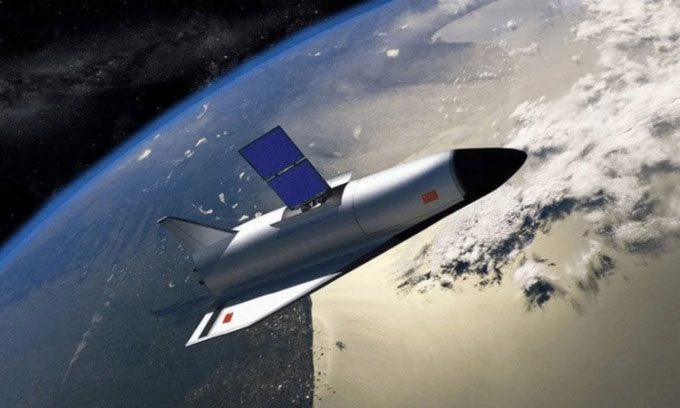A team of researchers is working on developing an electromagnetic gun that can launch aircraft into space at high speeds.
Chinese scientists and engineers are striving to integrate significant advancements in both electromagnetic propulsion and hypersonic flight in recent years. Essentially, their goal is to use a gigantic electromagnetic launch track to help hypersonic aircraft accelerate to Mach 1.6 (1,975 km/h). After that, the aircraft will detach from the track, ignite its engines, and enter space at speeds up to 7 times the speed of sound (8,643 km/h). This 50-ton spacecraft, longer than a Boeing 737, is part of the Tengyun project announced in 2016, as reported by Mail on March 14.

Design of China’s spacecraft. (Photo: Weibo).
Using the aircraft’s own energy for takeoff requires a massive amount of fuel. To ensure safety during low-speed takeoff, scientists and engineers need to adjust the aerodynamic design and engine placement, impacting flight performance at high speeds. However, the team of experts working on the project is confident they can address various challenges.
“Electromagnetic propulsion technology offers a promising solution to overcome these challenges, becoming a strategic technology pursued by leading countries around the world“, said scientist Li Shaowei from the Flight Vehicle Technology Research Institute under the China Aerospace Science and Industry Corporation (CASIC), in an article published in Acta Aeronautica.
To test their hypothesis, CASIC, one of China’s leading defense and aerospace contractors, has built a high-speed vacuum electromagnetic propulsion test facility 2 km in Daidong, Shanxi Province. This facility can propel objects weighing up to 1,000 km/h, close to the speed of sound. In the coming years, the length of the test track will be increased to achieve a maximum operational speed of 5,000 km/h.
This specialized electromagnetic propulsion facility supports the development of the next generation of high-speed rail, while also gathering important scientific and technical data for the space-based electromagnetic launch project. Meanwhile, in Jinan, the capital of Shandong Province, another massive electromagnetic track supporting high-speed electromagnetic towing experiments is also in operation under the supervision of the Chinese Academy of Sciences (CAS).
China is not the first country to propose an electromagnetic launch system for space. Such ideas date back to the Cold War era. In the 1990s, NASA attempted to turn the concept into reality, with the initial step being the construction of a mini test track 15 meters long. However, due to a lack of funding and technical difficulties, the actual length of the completed track was less than 10 meters. Ultimately, the project was abandoned, and the government and military leadership redirected resources towards developing low-speed electromagnetic catapult technology for aircraft carriers. However, the USS Ford, the first aircraft carrier equipped with this new technology, also faced numerous issues. Due to significant setbacks in electromagnetic propulsion technology, the U.S. military halted the development of several related projects, such as electromagnetic guns, and allocated budgets to hypersonic missile programs.
In the early stages of the research, Li and colleagues discovered that NASA did not conduct tests in any wind tunnels to ensure the survivability of the spacecraft detaching from the track. NASA’s original idea was to accelerate the space shuttle to 700 km/h, sufficient to avoid the need for rockets, but Chinese scientists argued that this speed was too low. However, as the speed increases, the airflow between the aircraft, the electromagnetic tow vehicle, and the track on the ground becomes very complex. Therefore, one of the first things the project team needed to confirm was that the aircraft would safely detach from the track.
Li’s team conducted computer simulations and wind tunnel tests. The results revealed that when the aircraft crossed the sound barrier, many shock waves spread along its underside, colliding with the ground and creating reflections. The shock waves disrupted the airflow, introducing low-pressure pockets between the aircraft, the electromagnetic tow vehicle, and the track. As the tow vehicle reached its target speed, subsequently releasing the aircraft and braking suddenly, the initial turbulent airflow lifted the aircraft, before transitioning to a downward thrust after four seconds, according to wind tunnel test results.
If there were passengers on board, they might experience dizziness for a brief period or encounter a state of weightlessness. However, as the distance between the aircraft and the track increased, the intensity of the airflow gradually decreased until it completely disappeared. Along with the engine noise, the aircraft enters a phase of rapid ascent. Although further real-world testing is needed, the research team concluded that this method is safe and feasible. While SpaceX’s reusable rockets have reduced satellite launch costs to $3,000 per kilogram, some scientists estimate that electromagnetic launch systems could lower costs to $60 per kilogram.





















































